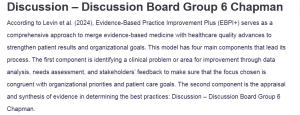Discussion – Discussion Board Group 6 Chapman
According to Levin et al. (2024), Evidence-Based Practice Improvement Plus (EBPI+) serves as a comprehensive approach to merge evidence-based medicine with healthcare quality advances to strengthen patient results and organizational goals. This model has four main components that lead its process. The first component is identifying a clinical problem or area for improvement through data analysis, needs assessment, and stakeholders’ feedback to make sure that the focus chosen is congruent with organizational priorities and patient care goals. The second component is the appraisal and synthesis of evidence in determining the best practices: Discussion – Discussion Board Group 6 Chapman.
This would go a long way in ensuring the proposed interventions have a strong basis on reliable evidence resulting from systematic and critical appraisals of up-to-date research that clearly integrates its findings. The next stage of the model involves developing and implementing context-specific interventions by considering the patient demographics, available resources, and organizational culture. This stage ensures relevance and feasibility through an interdisciplinary effort. Finally, the model emphasizes evaluation and dissemination: outcomes of the intervention are measured against predefined benchmarks, and the results are shared in order to spread more successful practices.
Furthermore, the strengths of the EBPI+ model are that it is a structured and systematic approach that ensures coherence and dependability in practice changes. A high spot in EBPI+ is that it emphasizes interdisciplinary collaboration, gathering expertise from every quarter and bringing a sense of shared responsibility to the table. Also, emphasis on evaluating evidence offers assurance of interventions that work and limit ineffectiveness, yet further damage the current best practices, as noted by Grys (2022).
This iterative design creates an enabling process of regular reassessments so the developing evidence dynamics and sustainability requirements continually come forward through revised understanding; otherwise, it ensures that an originally effective activity still appears relevant and ongoing, though of a lengthy term generation. As explained by White et al. (2021), because the EBPI+ model addresses both the “what” and “how” of practice improvements, this model bridges both research and clinical gaps in practice to improve quality safety and thus improves outcomes for patients.
References
Grys, C. A. (2022). Evidence-based practice, quality improvement, and research. Nursing, 52(11), 47–49. https://doi.org/10.1097/01.nurse.0000889812.89287.45
Levin, R. F., Burke, R. E., & Keefer, J. M. (2024). The Evidence-Based Practice Improvement+ model: Testing and evolution. Evidence-Based Practice Improvement: Merging Evidence-Based Practice and Quality Improvement, 33.
White, J., Grant, K., Sarkies, M., & Haines, T. (2021). Translating evidence into practice: a longitudinal qualitative exploration of allied health decision-making. Health Research Policy and Systems, 19(1). https://doi.org/10.1186/s12961-020-00662-1
ORDER A PLAGIARISM-FREE PAPER HERE
We’ll write everything from scratch
Question 
Module 2: Discussion – Discussion Board Group 6 Chapman
Files:
- Weekly Discussion Board Grading Criteria (8).docx (Attached)

Discussion – Discussion Board Group 6 Chapman
